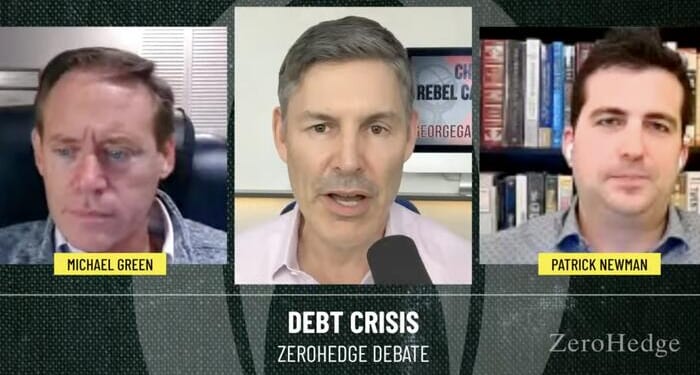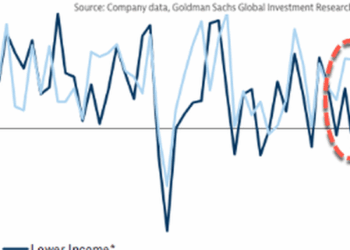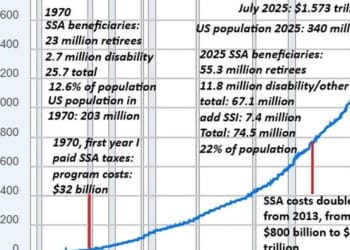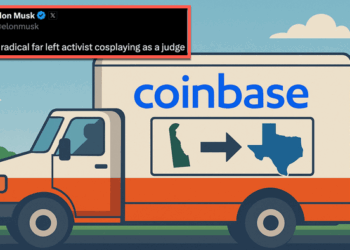We’ve surpassed $38T in debt, and we’re still no closer to balancing the budget. Instead, Republicans want to add another $2T in deficit spending, while Democrats want to add $3T.
Where does it end? https://t.co/SMfFjMm3sJ
— Rand Paul (@RandPaul) October 23, 2025
With U.S. debt blasting past $38 trillion, the question isn’t if the reckoning comes—it’s how to face it. In a fiery ZeroHedge Debate hosted by George Gammon of the Rebel Capitalist Show, Michael Green of Simplify Asset Management argued that “kicking the can” can buy innovation and growth, while Mises Institute’s Patrick Newman countered that endless borrowing is “a moral and economic fraud” destined to collapse under its own weight. Keynesian optimism met Austrian discipline.
Here were the highlights for those who missed it:
But who will build the roads?
The good ol’ libertarian road construction debate emerged.
Newman argued that “the private sector can build it—and they have built infrastructure.” He warned that government projects may look impressive but hide unseen costs: “We’re not looking at what would have been built with those resources… would it have been a better quality road or a road with different types of branch lines?” State spending also distorts efficiency by the nature of how economists compute GDP: “The government’s contribution [to GDP] is what it spends. The private sector’s contribution is what other people spend on it.”
Newman’s conclusion: “I don’t think you need taxes to pay for various goods and services that only the government can pay.”
Green fired back that “the simple reality is that they [private sector] don’t” build such projects where it really matters. Conceding that private efforts are more efficient, he emphasized that “the hurdle cost for the private sector is much higher,” meaning fewer roads would ever get built—especially those connecting “a small rural community with a larger city.” Green defended the public role as one of necessary subsidy: “Subsidies create more of a good than you would otherwise have. The private sector would benefit from scarcity. That’s antithetical to the idea of developing a resource that doesn’t accrue the benefits to the private sector naturally.”
Newman countered with history, invoking the railroad boom: “Most of railroad infrastructure was privately funded… about 75% of the funds used to build railroads during the Second Industrial Revolution came from the private sector.” He cited historian Richard White to claim that “government subsidies caused railroads to be built ahead of demand,” leading to bankruptcies and inefficiency—proof, in his view, that the state’s heavy hand “built inefficiently” while “private sector lines were built basically around it.”
— ZeroHedge Debates (@zerohedgeDebate) October 24, 2025
Stagflation… an Austrian lie?
Green challenged the popular “stagflation” narrative of the 1970s, arguing that it’s “a fundamental misunderstanding that continues to haunt the debate today.” While Austrians like Newman frame the decade as proof that government mismanagement and monetary expansion produced both high inflation and stagnation, Green countered that the data tell a different story. “The rate of job growth in the 1970s was 2.4%,” he said, “while the labor force grew at 3.6%. In other words, demand grew far more rapidly than supply. It was not stagflation.”
He attributed the inflation not to failed policy but to rapid demographic change—“baby boomers and women entering the labor force and minorities being able to participate in the regulated economy.” The result, he said, was “one of extraordinary growth” in which new workers needed “cars, apartments, dishwashers, suits—all in short supply relative to demand.”
Austrians like Newman, however, would view that very inflation as evidence that the Fed lost control of prices and eroded real wages—classic symptoms of stagflation. Green rejected that framing, arguing that “the celebrated Volcker period” that followed did more harm than good by “raising the cost of capital so high” it helped deindustrialize America. In short, while Austrians see the 1970s as a cautionary tale of government excess, Green sees it as an overheated boom misread as failure.
— ZeroHedge Debates (@zerohedgeDebate) October 24, 2025
Check out the full debate below for more deep dives into economic history as the timeless Austrian-Keynsian battle wages on:
Tonight’s ZeroHedge Debate: Michael Green vs Patrick Newman on Solving the Debt Crisis https://t.co/mvAU4PVDcM
— zerohedge (@zerohedge) October 23, 2025
Loading recommendations…

















